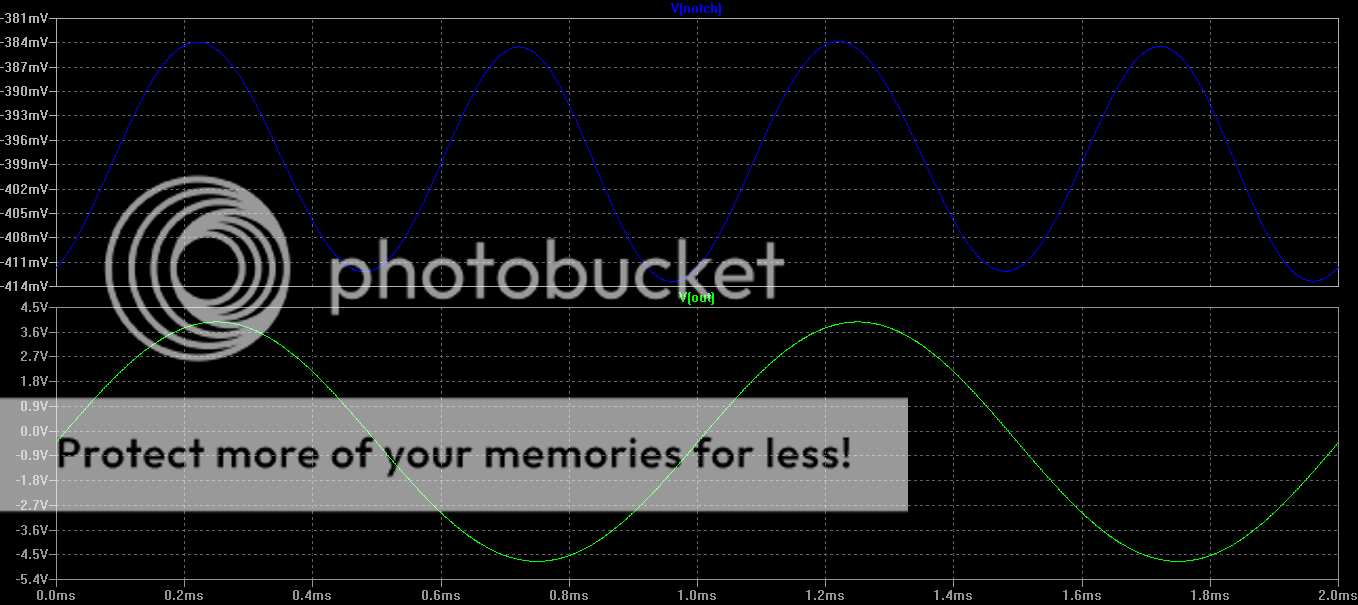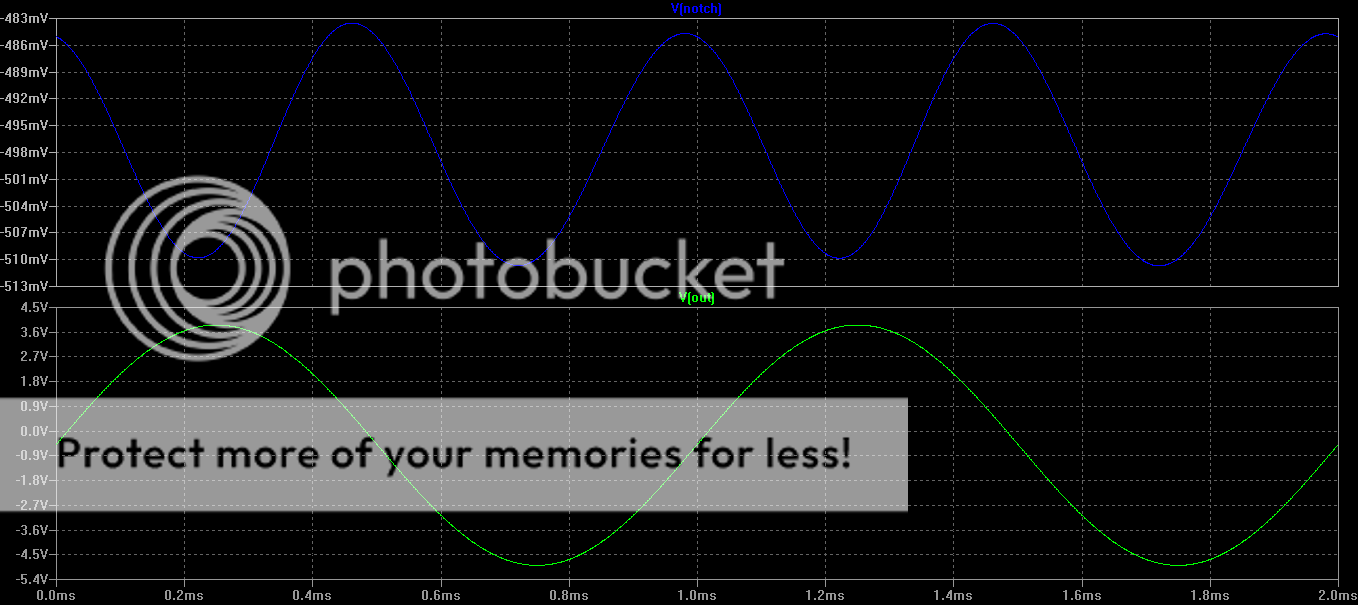Hi Ihquam
After reading the article again, I still don't see the description of negative phase 2nd harmonic.
Could you explain what I am not seeing?
Thanks
🙂
I tried to find one of Nelson's articles that shows the dominant negative phase second harmonic waveform, but have not yet found it.
If you look at the waveform in the F7.pdf article you will see that H2 in the residual waveform has minima at the same times when the H1 has its maxima. This is referred to as "negative phase" (in relation to the fundamental). If H2 had its maxima at the same times as the fundamental, that would be "positive phase".
I tried to find one of Nelson's articles that shows the dominant negative phase second harmonic waveform, but have not yet found it.
If you look at the waveform in the F7.pdf article you will see that H2 in the residual waveform has minima at the same times when the H1 has its maxima. This is referred to as "negative phase" (in relation to the fundamental). If H2 had its maxima at the same times as the fundamental, that would be "positive phase".
Cheers.
I was also expecting to see a difference in magnitude between positive and negative in the residual waveform, but there is no obvious difference.
These articles do not explain the difference between positive and negative phase harmonic in the residual waveform.
If you look for YouTube videos of Burning Amp, there was once Papa describe the sound of the different "2nd harmonic phase" in its relationship with fundamental as described by Ihquam. To view that you need a distortion analyzer with residual output. He describe most people find a positive phase more forward and in your face while negative phase to be more ethereal. Hope that helps [emoji6]These articles do not explain the difference between positive and negative phase harmonic in the residual waveform.
didnt Ilquam explain that above?
Yes, but if you look at the residual it goes negative when the fundamental is positive (confirms theory) but also goes negative when fundamental is negative (disagrees with theory), so without a direct Nelson Pass quote, I don't have too much faith in it.
Oh yea of little faith. 🙂
Usually you would expect to see a difference in amplitude between positive and negative phases but is not easily seen in the picture.
If you look for YouTube videos of Burning Amp, there was once Papa describe the sound of the different "2nd harmonic phase" in its relationship with fundamental as described by Ihquam. To view that you need a distortion analyzer with residual output. He describe most people find a positive phase more forward and in your face while negative phase to be more ethereal. Hope that helps [emoji6]
That still does not help identify positive or negative phase harmonic in the F7 manual.
Ihquam could be absolutely correct I just haven't found that definition anywhere. I hope he can find the relevant quote cause that would definitely be a nice piece of information.
I tried to find one of Nelson's articles that shows the dominant negative phase second harmonic waveform, but have not yet found it.
If you look at the waveform in the F7.pdf article you will see that H2 in the residual waveform has minima at the same times when the H1 has its maxima. This is referred to as "negative phase" (in relation to the fundamental). If H2 had its maxima at the same times as the fundamental, that would be "positive phase".
After simulating both positive phase and negative phase 2nd harmonic distortion and comparing the fundamental with the residual wave form, this appears to be correct.
It would be nice if you could also locate an article about it.
Anyway it was always highly likely this would be the case in this circuit due to the nature of the parts.
The trough of a pure second harmonic component of a pure sine wave will always be exactly aligned with the peak of its fundamental.
The oscilloscope shot on the F6 manual linked shows a mix of harmonics which is why the troughs and peaks don't line up. Over a longer timebase, you would probably expect to see a pattern.
I would also like to read more about inversion of harmonic components, how they might be achieved and some ideas on how to invert them in practical circuitry. Sounds interesting.
The oscilloscope shot on the F6 manual linked shows a mix of harmonics which is why the troughs and peaks don't line up. Over a longer timebase, you would probably expect to see a pattern.
I would also like to read more about inversion of harmonic components, how they might be achieved and some ideas on how to invert them in practical circuitry. Sounds interesting.
Last edited:
The trough of a pure second harmonic component of a pure sine wave will always be exactly aligned with the peak of its fundamental.
.
Are you saying that this occurs regardless of positive or negative phase 2nd harmonic?
After simulating both positive and negative phase 2nd harmonic conditions it appears what Ihquam suggested is correct, ie a negative phase 2nd harmonic residual waveform will go negative (minima) when the fundamental goes positive (maxima).
A positive phase second harmonic residual waveform will go positive (maxima) when the fundamental goes positive (maxima).
I think phase inversion of a harmonic is a manipulation. A pure harmonic component (if any such thing were to exist, which I don't think does) would always be in phase with the fundamental.
Obviously, I'm also asking the question about inversion of the second harmonic and how it may be forced into or removed from a circuit. Is just the differing transconductance of the two halves sufficient?
Edit: OTOH in a real musical instrument, harmonic tend to mix freely in order, magnitude and phase. I understand that.
Obviously, I'm also asking the question about inversion of the second harmonic and how it may be forced into or removed from a circuit. Is just the differing transconductance of the two halves sufficient?
Edit: OTOH in a real musical instrument, harmonic tend to mix freely in order, magnitude and phase. I understand that.
I think phase inversion of a harmonic is a manipulation. A pure harmonic component (if any such thing were to exist, which I don't think does) would always be in phase with the fundamental.
.
Ok here it is. Not sure what to believe with this but here are the simulations.
Tweaking circuit for dominant positive phase 2nd harmonic is giving this result (blue is residual harmonic waveform)

Dominant negative phase 2nd harmonic gives this result (blue is residual harmonic waveform) which appears to agree with Ihquam.

That seems to be only applicable for the first half of the sine wave.
When the fundamental switches to the opposite end of its swing, the relationship reverses. Your pictures capture this remarkably well.
As I originally thought, this may be only an academic discussion.
When the fundamental switches to the opposite end of its swing, the relationship reverses. Your pictures capture this remarkably well.
As I originally thought, this may be only an academic discussion.
The pattern repeats on each maxima point of the fundamental.That seems to be only applicable for the first half of the sine wave.
When the fundamental switches to the opposite end of its swing, the relationship reverses. Your pictures capture this remarkably well.
As I originally thought, this may be only an academic discussion.
I created a very strong 2nd harmonic to get this nice clean waveform.
...and on the troughs, the relationship swings exactly the other way.
Yup it's a good illustration. Two thumbs up 🙂
In practice, with a mix of harmonics at different frequencies/ordera/levels it may not be possible to get all the ducks to line up so neatly, and hence not sure how much/if it affects the listening experience? I am not convinced that it is.
By 'it' i refer to the phase relationship between the findamental and its harmonic component.
Yup it's a good illustration. Two thumbs up 🙂
In practice, with a mix of harmonics at different frequencies/ordera/levels it may not be possible to get all the ducks to line up so neatly, and hence not sure how much/if it affects the listening experience? I am not convinced that it is.
By 'it' i refer to the phase relationship between the findamental and its harmonic component.
The point is the positive (or negative) maxima of the 2nd harmonic coinciding with both the maxima and minima of the fundamental. By virtue of it being second harmonic, the relationship of the sum would create either positive swing expansion + negative compression OR negative swing expansion + positive swing compression.
I'm just trying to determine whether this is a legitimate method to characterize positive vs negative phase 2nd harmonic distortion.and hence not sure how much/if it affects the listening experience? .
I'm not really interested in what the audible differences might be at this point in time.
I have been reading with fascination what you guys are talking about without realizing more information was available on the F7 at 6moons.
6moons audioreviews: FirstWatt F7
http://www.6moons.com/audioreviews2/firstwatt2/F7.pdf
Perhaps I missed these links somewhere back on this thread.
6moons audioreviews: FirstWatt F7
http://www.6moons.com/audioreviews2/firstwatt2/F7.pdf
Perhaps I missed these links somewhere back on this thread.
- Home
- Amplifiers
- Pass Labs
- First Watt F7 review